Sunday, April 29, 2007
What a Year!
It is amazing to think how tea and wine have connected me with individuals of completely different backgrounds and cultures. And yet our common interests have build pillars strong enough to endear us together. In my humble opinion, such is the true virtue of the grapes and the leaves.
If there is one person who I can blame for the genesis of Adventures in Tea & Wine, then I would heartily point my finger in compliment at MarshalN. Thanks to him, I am now equally as obsessed about blogging and tea as I am about wine.
Thank you all for your readership, friendship, kind comments, criticism and encouragement, without which this blog would have been less meaningful and my knowledge would have been only a tiny fraction of what it is today. There is still a lot more to learn, however.
In return, I sincerely hope that my musings and irreverent banter have somehow also contributed to our communal effort in exploring these noble libations. I also wish that our friendship will develop, persevere and extend towards other branches of our lives in the pursuit of a rewarding and artful journey through life.
If you have any suggestion on how I can improve this blog – from whatever angle it may be – please do not hesitate for a millisecond to let me know.
Let the adventure continue on...
With infinite gratitude and humility,
Phyll
Saturday, April 28, 2007
Dungeon
in darkness and humid air
'till the master calls
(thunder, lightning and sinister laughter!)

A snapshot of the offsite cellar (one of the corridors) where I keep my wine and pu'er tea. Contant temperature and humidity at 58°F and 65%, respectively.
Nothing inspiring, nothing fancy. The wines and teas can not see where they are anyway.
Friday, April 27, 2007
TN: 2005/06 Menghai Yunnan - Tibet Caravan Shou Pu'er
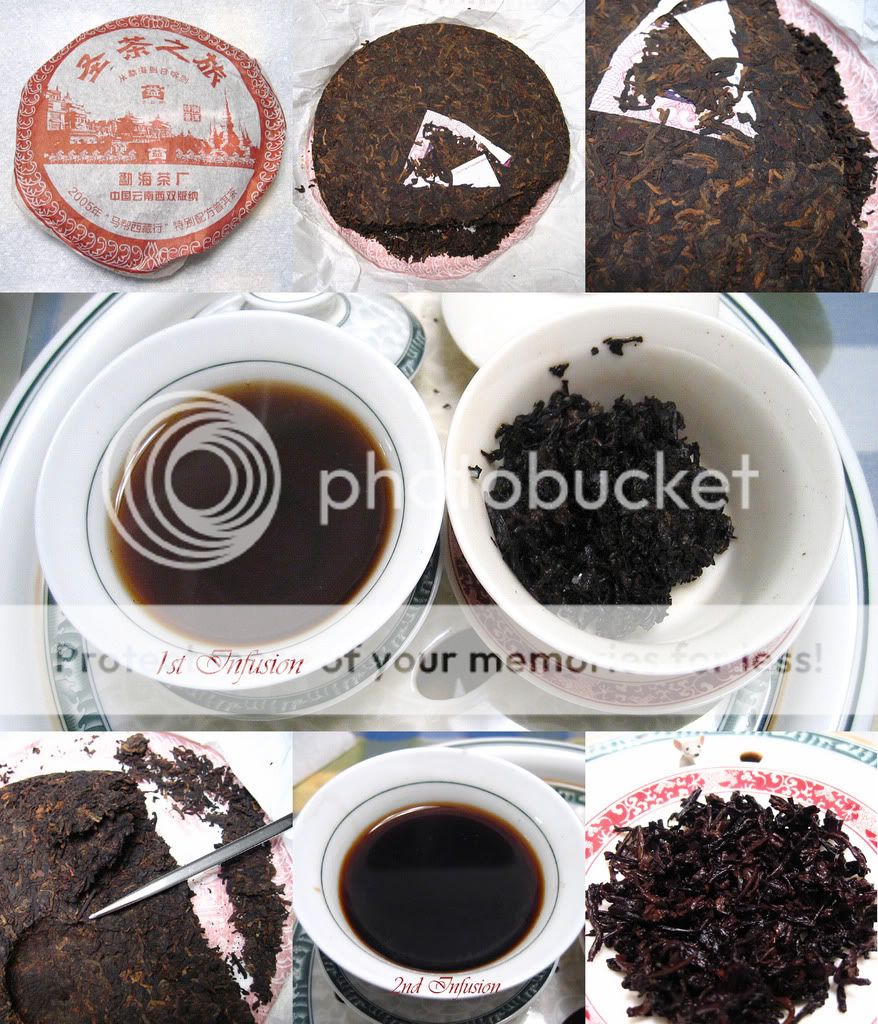 While inventorying my stash, I found this shou pu'er tucked among the other shou I own (not much but growing). It is the same one that Scott Wilson of Yunnan Sourcing mentioned in the 1st volume of The Art of Tea. In the article, his response to the question which Puerhs of 2006 will prove to be the best investment was:
While inventorying my stash, I found this shou pu'er tucked among the other shou I own (not much but growing). It is the same one that Scott Wilson of Yunnan Sourcing mentioned in the 1st volume of The Art of Tea. In the article, his response to the question which Puerhs of 2006 will prove to be the best investment was:".... The 2006 Menghai Yunnan to Tibet Horse Ripe Puerh cake, on the other hand, only had one unique batch and will not be produced again after this year. [This] tea's wholesale price had already doubled within 6 months of its release...."
Oh well, so what, I thought. I only have 2 beengs and they are going nowhere but down my throat. I purchased each beeng for $19 from Scott back in May of last year. I would have profited a whopping $40 or more by now. Big deal. I would have thought differently if I had a jian or two, however.
Tasting Note
The dry leaves emanated a clean and salty sweet aromas. Once wet, it smelled like smoked meat / fish / shrimp that was strangely quite inviting. When the leaves had cooled down it reminded me of root beer (sarsaparilla), just as the V93 Menghai shou tuocha did. The root beer characterization was brought to my attention by Davelcorp, who I thought made an accurate association.
The thick, black, opaque liquor tasted smooth, clean and creamy. Fortunately, it gave no pond-y taste. The tea finished creamy with shades of sweet and metallic notes. From the 3rd infusion onwards, a hint of all around sweetness was present. Brewed well for 8 infusions with enough juice for a few more. In many respects, this is a rather different shou pu'er than most that I have tasted so far.
I enjoyed it very much. 4 stars (vg)
Thursday, April 26, 2007
Making Sense of Tea Collecting
When the tea dust settled, my spreadsheet said I have about 48 kilograms (~106 lbs) of pu’er. Assuming a standard beeng weighs 357 grams, then I have the equivalent of 134 beengs or 19 tongs. By all means mine is a small stash when compared to the collection of some other pu’er enthusiasts I know. Nevertheless, I probably have slightly more tea than many tea drinkers have in their cabinets. Showing off how hefty or how little I have is not my intention here.
After knowing exactly how much tea I have, one question loomed over my head: just exactly how much tea do I have? Being a wine lover and a small time collector, I tried to make sense of my tea collection the way I know how. So I calculated how many standard 750ml bottles my tea – the brewed liquor, mind you – can fit into. Here is how my mind works:
Conservatively speaking, 7 grams in a vessel that pours out 100 ml of tea can be infused for 10 times. That is saying 7 grams of dried pu’er leaves can produce 1,000 ml of non-alcoholic libation. With this logic, I have 9,143 bottles of tea.
Some would say that my computation is too conservative because one really can infuse them up to 20 times or more. Well, if that is so, then I have the equivalent of about 18,259 bottles of pu’er tea.
Yikes!
I like pu’er. However, I also love my oolong of different types, my Darjeeling, my wine, my whisky and, yes, plain water, too. I estimated that if I drank 2 sessions of pu’er per week on average, then the 48 kilograms stash will last for 66 years!
I have often heard about wealthy individuals who own an upward of 10,000 bottles of wine in their private cellars, and I have always thought they must be mad. Those few people who own 20,000 or more bottles for their “personal consumption”, well, the roads will be much safer without them. And here I am, sitting on top of 9,000 to 18,000 plus bottles of tea.
No, I have nothing against wealthy people. I inspire to be one, in fact.
27 of the 48 kilograms that I own are of vintage 2005. It’s the year my daughter was born in. My hope and wishes are that one day, when I’m dead from pu’er overdose, she will inherit these teas in addition to a sizable, generation-skipping, non-taxable trust fund. While the trust can easily be arranged, who can really know how the tea will fare. The aging potential of pu’er is still a big mystery to me, even after having downed many types and soaked myself with all the information I can get ad nauseam. Here is to planning and hoping that she will like the taste of pu'er in the first place.The moral of this post? I should buy tea (and wine) with my consumption habit and future plan in mind because they really are just for personal use.
Wednesday, April 25, 2007
An E-mail From Mary Lou Heiss
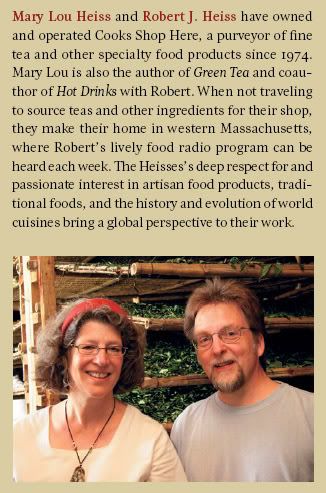 Two of the people that I look forward to meeting with are Mary Lou and Robert J. Heiss, the husband-and-wife team and owners of Cooks Shop Here in Northampton, Massachusetts. Mary Lou is the author of Green Tea: 50 Hot Drinks, Cool Quenchers, and Sweet and Savory Treats (Harvard Common Press, 2006), and the couple are co-authors of the soon-to-be released tea book titled The Story of Tea (Ten Speed Press).
Two of the people that I look forward to meeting with are Mary Lou and Robert J. Heiss, the husband-and-wife team and owners of Cooks Shop Here in Northampton, Massachusetts. Mary Lou is the author of Green Tea: 50 Hot Drinks, Cool Quenchers, and Sweet and Savory Treats (Harvard Common Press, 2006), and the couple are co-authors of the soon-to-be released tea book titled The Story of Tea (Ten Speed Press).Mary sent a kind e-mail to me saying:
 Dear Phyll,
Dear Phyll,I have just discovered your tea blog and am finding it very interesting. I wanted to let you know that my husband and I have just completed a very large and comprehensive book on tea which will be published this fall by Ten Speed Press in Berkeley.
...The book has a very educational slant and is fully-illustrated with tea processing photos from our tea buying trips to China and Japan.
I assume that you will be in Pasadena for the Pu-erh tasting as will we.
Best wishes,
 Mary Lou
Mary Louwww.CooksShopHere.com
Thank you, Mary, and I look forward to meeting and getting tea drunk with you and your husband in Pasadena!
Folks, FYI below is the cover shot and the short synopsis of The Story of Tea, which will be available in October 2007. I can't comment much on it, but judging the book by its cover, it's something that I'd like to have on my bookshelf.
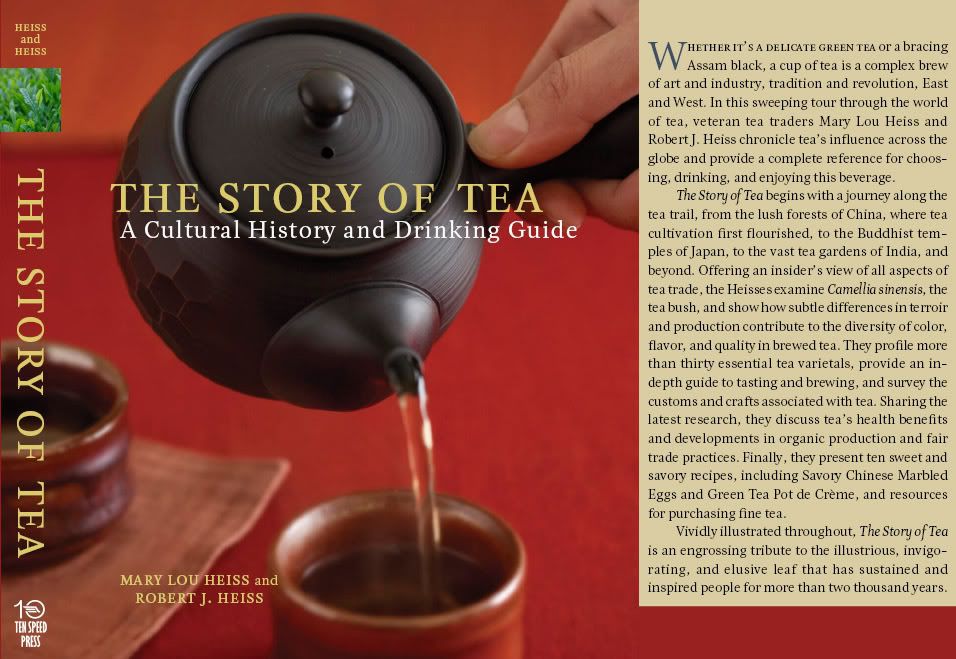
Tuesday, April 24, 2007
TN: Japanese Sencha -- 2007 Spring Tenbu & Tenbu Fuka
During this "thunderstorm", I experimented with the Japanese Sencha samples that came from T Ching. The Sencha teas are named Tenbu ("Dance in Heaven") and Tenbu Fuka ("Dance in Heaven Profound").
------------------------------------------------------------
Edit 4/25/2007: According to Dr. Bushberg of T Ching, the Tenbu Fuka is not the higher or the lower quality tea. "They are from the same early picking but Tenbu Fuka is deeper steamed in a special way, so the pores of the tea leaves are more open and the constituents dissolve easier and faster in the hot water. The color of the infusion is deeper green and the taste is a little stronger."
------------------------------------------------------------
I have never had Sencha before and I must admit that my knowledge of Japanese teas at this moment is pretty much nil, if I don't count the supermarket genmai-cha, mugi-cha and the restaurant Yamamotoyama brand bagged green tea that I often had with my Japanese roommates back in college days.
More about these wonderful half-shaded Senchas' background here.
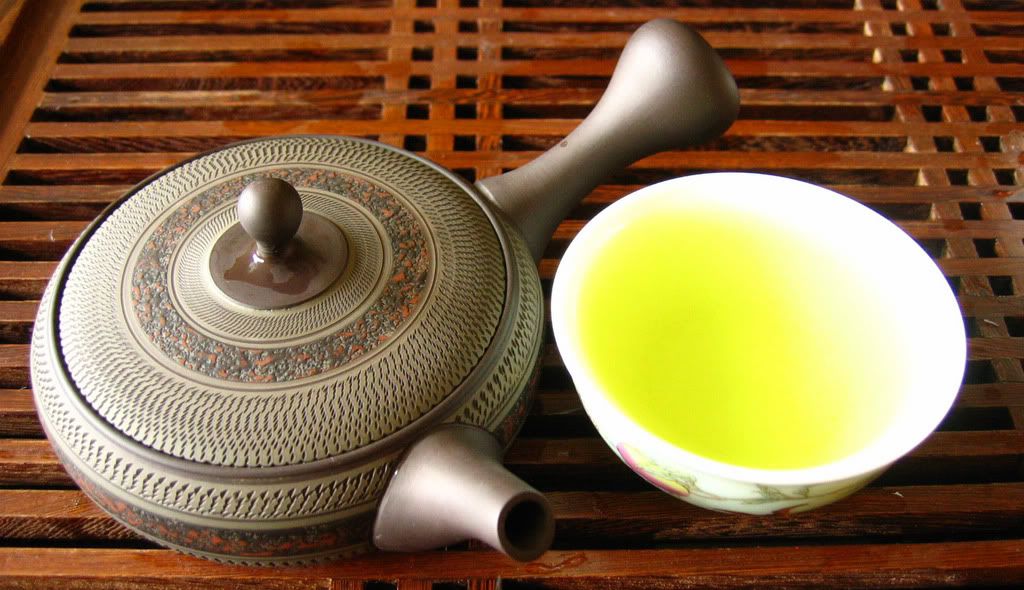 Parameter
ParameterVolvic bottled water, 60-65 C, 3gr:200ml or similar ratio. 60s, 15s, 15s, 15s, 30s.
Dry leaves
Deep emerald green, healthy and fresh looking. The leaves of both samples were visually similar. While there was an equal amount of fanning, those that were not were quite short in length. Is such brokenness representative of both teas’ original condition, or perhaps it was broken in transit?
Highly fragrant! The smell was savory, buttery, green and sweet all at once. I noticed that the Tenbu Fuka’s nose was sharper and had a slightly higher note than that of the Tenbu. Both reminded me of a delicious Japanese food seasoning (not diced seaweed). I was almost tempted to sprinkle some on top of steamed rice and eat it as is.
In summary, by looking at and smelling the dry leaves alone I was hard pressed to find any differences between both teas.
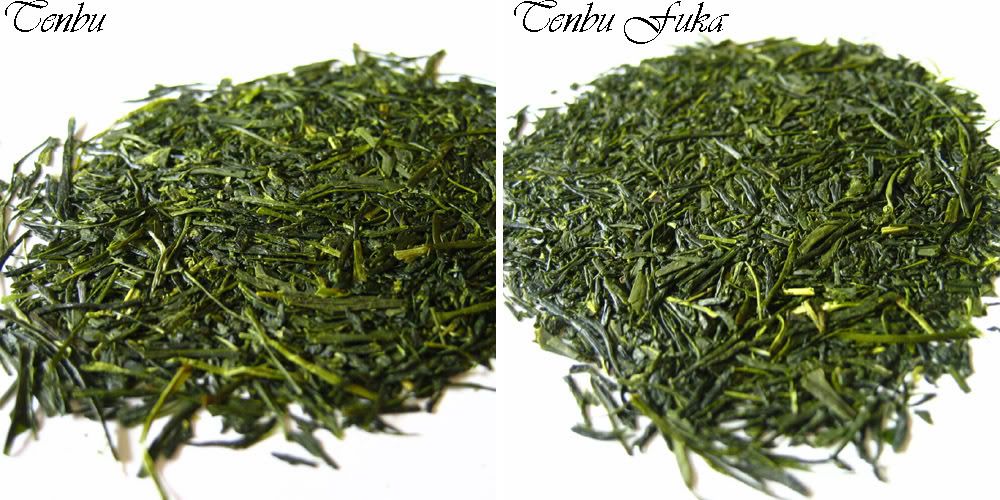
Tasting Notes
There was a considerable amount of soft fanning that flowed out of the brewing vessel into the cup (unfiltered). Not liking that much tea dust, I employed a fabric mesh filter, which became clogged halfway through pouring out of a gaiwan. The new Kyushu teapot that I purchased from T Ching has a built-in metal strainer that kept the fanning in the pot quite effectively. I wonder if customarily this tea is served with a lot of tea bits in the cup or not.
Tenbu: The first infusion was light green in color and the liquor was cloudy. It tasted vegetal with a creamy sweet undertone and buttery texture. The second infusion was bright, limey green and stronger and thicker tasting than the first, which made the tea rather soupy. The third infusion was weaker and more balanced in my opinion. The fourth and fifth infusions were watery. I enjoyed the 1st and the 3rd infusions the most out of each five-cup session.
I should note that I felt my mouth and lips as if coated with grease, though I believe it is due to the polyphenols, the amino acid (L-theanine?) or both. The texture was present at every session I had, whether the tea was brewed in a clay teapot or in a gaiwan.
Tenbu Fuka: Similar tasting note to the Tenbu in most respect, except it was slightly more vegetal.
Photo of Tenbu session with the new Kyushu clay teapot
Photo of tea brewing in gaiwans
Photo of the 1st infusion
Photo of the 2nd infusion
Brewed Leaves
Wet, soggy mush. (Photo here)
Conclusion
I was quite surprised to find that the second infusion yielded a stronger and thicker cup of tea than the first, despite the fact that brewing time was cut to one-fourth of the first. By the third brew, the tea was weaker than the second, but was still enjoyable. The fourth and fifth brews were too watery.
Having no prior benchmark against which these Sencha’s can be evaluated, I would defer any attempt at scoring until I have tried and experimented with more teas of the same genre. For these samples, I loved the smell of the dry leaves, though I found the tea too vegetal for my preference. The presence of too much tea leaves in the cup was also rather hard to enjoy.
Thank you, Michelle and Sandy (of T Ching), for the tea samples and the opportunity! This was an eye-opening -- or rather a mouth-watering -- experience.
Thursday, April 19, 2007
Miscellaneous Catching Up
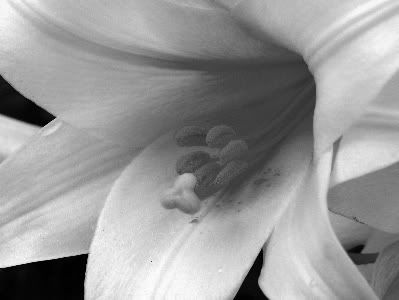 My prayer and thoughts go out to the families and friends of those who were senselessly slain at Virginia Tech. I am particularly moved by the braveness of Professor Liviu Librescu who went towards and blocked the deadly threat in order to save many and sacrificed his own life. May they rest in peace and be remembered lovingly forever.
My prayer and thoughts go out to the families and friends of those who were senselessly slain at Virginia Tech. I am particularly moved by the braveness of Professor Liviu Librescu who went towards and blocked the deadly threat in order to save many and sacrificed his own life. May they rest in peace and be remembered lovingly forever.Though my blog has been static lately, I have actually been quite active within the tea and wine blogospheres. I enjoy visiting other blogs to leave some thoughtlessly written comments just because. The collective online knowledge and wisdom of those who are passionate about tea and wine are immense! I've learned so much from consuming their writings and personal opinions. They never fail to freshen my perspectives.
Some of the interesting happenings lately within the tea and wine blogospheres:
1. Bearsbearsbears made his own pu'er tea cakes (35kg of them!)...
2. And he wrote an article for the 2nd issue of The Art of Tea magazine, too!
3. Brent, a Tea Nerd (like me!), made me realize that, unlike in wine, tannins is not what makes tea feels puckery. Mr. Sanwar M. Changoiwala's excellent article on Chadao about tea and polyphenols confirmed this as well. So I guess it will be "polyphenolic" instead of "tannic" from now on when I describe tea.
4. Imen of Tea Obsession is opening a tea lounge!
5. Houde Asian Art raised their pu'er prices...again.
6. Various discussions about the current state of pu'er price inflation (MarshalN, LJ, Tea Drunk).
7. Eric Asimov, the chief wine critic for the NY Times, contemplates on the topic of how technology changed the art of winemaking (is it still natural?)
As a result of my blogger's block (as in writer's block and nothing to do with China's overzealous censorship), this piece of news had likely become stale. But here it is anyway.
Two Saturdays ago I met three new tea friends: "Estif", who came down from San Francisco for the Easter weekend, Imen, who I have communicated with many times before, and T, who is a friend of Danica. The gracious host was Danica, again.
I think we managed to come across as quite fanatical to T in how we discussed, slurped and comment about the teas we drank that day. Fortunately, she was very open to the new experiences, and all of us could tell that she has got a taste for fancy teas! Another convert?
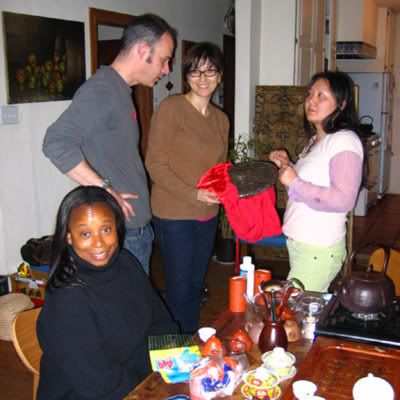
Lovely. Nutty and buttery with a long sweet and buttery aftertaste. 4 stars.
Good. Nutty and floral, but seemingly short on the aftertaste. I can’t say that I’m a big biluochun fan yet. 3.5 stars.
Light, thin and not expressive enough. Floral, grassy with a soft roasted taste. Came rather short of our expectations. 2 stars.
Delicious, complex and balanced. One of the better roasted Taiwanese oolongs I have ever tasted. 4 stars.
Expressive and charming. Brewed with little leaves and long steeping time in the silver teapot. Best tea of the day for me. Alas, its very pricey for a young 2006 tea. 4.5 stars.
Strong tasting. Don't remember much else. 3 stars.
Strong and kicked everyone's head pretty quickly. 3 stars.
Reverse Osmosis Water Is Not That Bad
We used three types of water that day: Fiji (artesian), Trader Joe's New Zealand (artesian), and reverse osmosis. Danica added about six drops of some ionic mineral supplement into the RO water in the 1.5 liter tetsubin to an excellent result! The supplemented reverse osmosis water was actually as good as or better than the expensive Fiji and New Zealand artesian water. More testing and comparing still need to be done, however.
Lastly, please meet my new ceramic tea friend. It's made by a miniature specialist company called Hagen-Renaker.
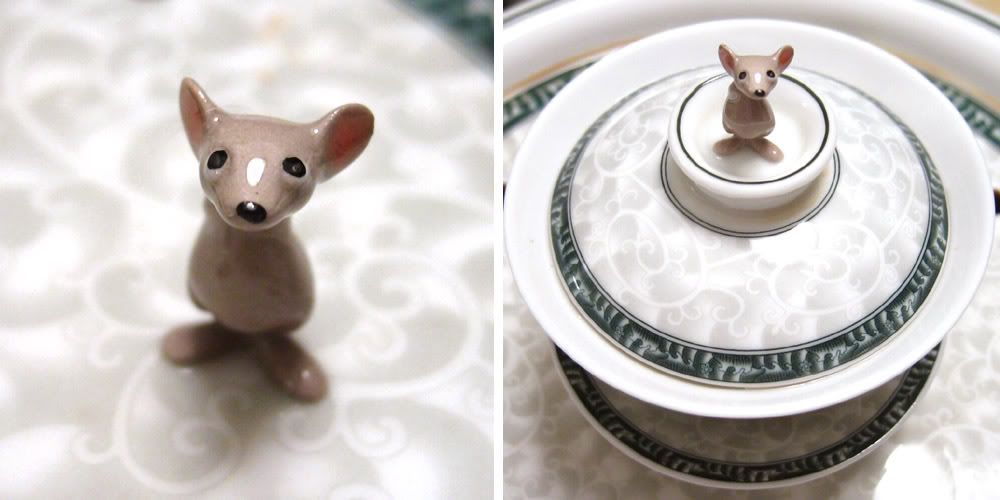
Sunday, April 8, 2007
The Sopranos & Saxon Brown

Just finished with watching The Sopranos (1st plug of the final season). Thought I needed a "Tony Soprano" kinda wine to match the potential intensity of the episode. So I cracked open a Napa Valley Syrah by Saxon Brown, a winery that is owned by Jeff Gardner and his wife. Jeff is the talented winemaker behind many well known CA wineries and Saxon Brown is his personal project.
 2002 Saxon Brown Syrah, Napa Valley
2002 Saxon Brown Syrah, Napa Valley(80% Syrah, 20% Cabernet Sauvignon)
$35 95 cases produced
This is drinking very nicely right now. Quite a change from a year ago (bottle variance?). The tannins has soften somewhat from my last visit in March of '06.
Deep, vibrant purple/garnet color. A big wine (like Tony). Copious amount of blackberry, plums, graphite and cocoa. Judicious amount of oak. Lively acidity gives this wine three dimensionality. Dark chocolate and espresso finish that stays on for about a minute...reminds me of a luscious tiramisu cake. Delicious and balanced.
This is quite an intense wine, I must say. Almost as intense as watching Tony fought bare hands with Bobby. 4 stars
Past tasting note (Mar 26 '06):
Pitch black/purple. Nose of dark plums and cocoa. There is also a slight yeasty smell to it. Soft oak. A bit hot in the back due to the 14.5% alcohol. Still quite tannic...need more time to soften, but the fruit elements probably won't hold up for as long as the tannin. This is a brooding syrah that struggles for but didn't achieve balance. 2.5 stars.
Winemaker's Note:
www.saxonbrown.com
Vineyard: This is our first Napa Valley wine and it was a lot of fun. The wine is a blend of 80% Syrah and 20% Cabernet Sauvignon. The Syrah was from a vineyard in Yountville and the Cabernet Sauvignon was from the Rutherford area. Both are great, impeccably-farmed vineyards. We only made 4 barrels of this wine so we treat it like gold.
Winemaking: As with all Saxon Brown wines, I really wanted this Syrah to be an expression of the site. Given that the wine is a blend of two varietals from two different vineyards it was challenging and fun to capture the site signatures in such a small production wine (95 cases). Both wines were kept separate for the first year, aging in new and one year old French oak barrels. After the first year the wines were blended and put back to the same barrels. The total time in barrels was 26 months.
Tasting Notes: Great intense color. The nose is as concentrated as a red wine can be, lots of dark rich fruit and amazing chocolate / mocha and lavender tones. On the palate this wine is almost thick with elegant tannins and a long finish. Please try to uncork about 30 minutes or so before serving to allow the wine to open —the effort will be well worth it.
An Eventful Saturday
Yesterday I started the day early to visit the Chinatown with my brother-in-law to pick up the Chinese paintings that were being custom framed (I posted about them below on April 1st). The framings were beautifully done! Allow me to show them off a little here :)
...and please meet the lady boss of the Chinese art-and-frame store who I talked about.
We then grabbed a quick yum cha at the Empress Pavilion right next door. Yum!
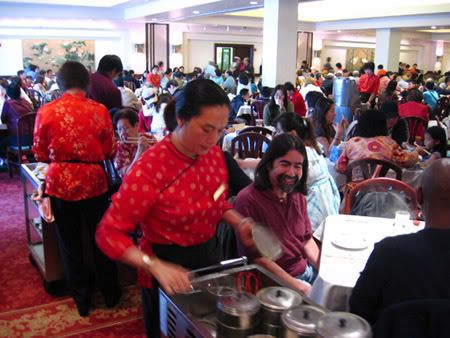
The yum cha had to be done quickly, however, because I was running late in picking up "Estif", a regular contributor on LJ Puerh Community, who is visiting from San Francisco for the Easter weekend. We had made a plan to meet with Danica and Imen for some serious tea drinking.
"Estif" and I arrived at Danica's at around 1:30pm and we spent 5 solid hours enjoying ourselves to a great company, conversation and a lot of tea. I decided to bring along an extra guest: the Bodhidharma himself (in the painting). He drank tea with us...or was it us who drank tea with him?
Next post: more about the tea session (as I am running late to be at my in-laws for our Easter family dinner).
Saturday, April 7, 2007
70% Said Who Cares If It's Healthy or Not
In fact, 70% of 6600+ people who voted on MSNBC.com agreed.
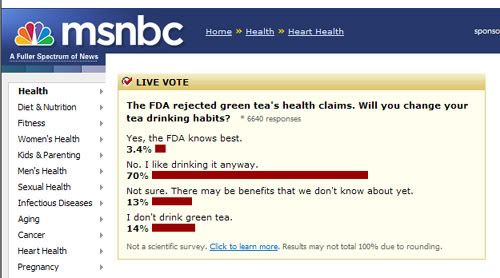
Click on the image to go to the article (rather old)
If you have followed my blog for sometime, you'd know that I am not one who preaches the health benefits of tea. I have always said, in essence, to drink tea and wine because they taste good. If in fact they are healthy, well, it's a plus. And not to forget: everything in moderation.
The focus of my previous article was really on the coincidence -- if there is such a thing -- of meeting a perfect stranger who turned out to be someone who had co-written medical articles on the benefits of green teas.
Thank you for your comment, Silverneedles!
Thursday, April 5, 2007
Two Men in a Sandbox
Naturally, we struck a casual conversation about our girls. That was when I learned that he came to the U.S. some 11 years ago from Shanghai and he is a professor of epidemiology at the prestigious UCLA School of Medicine (located within walking distance from the park we were at). Having nothing to relate to professionally, and being that he is a medical doctor from China, I shared with him my personal experiences with Chinese hospitals and the stark contrast on the policy of disclosing relevant information to the patients.
We chatted and parted ways shortly thereafter. At home, curious about the kind professor, I looked him up in the UCLA David Geffen School of Medicine’s online faculty directory. He is apparently a professor of molecular epidemiology and thoracic oncology. His profile page contains a long list of medical publications that he had written or co-written in China and in the U.S. Three of the many medical writings, coincidentally, are tea related, and one of them is quite relevant to me as a wine drinker (relevant parts highlighted in maroon).
A coincidence? If I meet him again next time, perhaps I should invite him for some tea. Here is a guy who has reviewed tea in microscopic detail, so to speak.
----------------------
----------------------
Lu QY, Jin YS, Pantuck A, Zhang ZF, Heber D, Belldegrun A, Brooks M, Figlin R, Rao J Green tea extract modulates actin remodeling via Rho activity in an in vitro multistep carcinogenic model.. Clinical cancer research : an official journal of the American Association for Cancer Research. . 2005; 11(4): 1675-83.
Abstract:
Center for Human Nutrition, University of California at Los Angeles, Los Angeles, CA 90095, USA.
Alteration of actin polymerization and loss of actin filaments is a marker of cellular dedifferentiation and early malignant transformation. To study this phenomenon, an in vitro human urothelial model consisting of two cell lines, HUC-PC and MC-T11, were incorporated into the study design. These two cell lines have different malignant transformation potential. The effect of green tea extract (GTE), a potential anticancer agent, on actin remodeling was investigated. Upon exposure to the carcinogen 4-aminobiphenyl (4-ABP), the untransformed HUC-PC undergoes malignant transformation whereas the transformed MC-T11 progresses from noninvasive to invasive tumor. GTE induces actin polymerization in MC-T11 cells in a dose-responsive manner, but this effect is less obvious in the untransformed, more differentiated HUC-PC cells, which natively have higher actin polymerization status. In contrast, GTE antagonizes carcinogen 4-ABP induced actin depolymerization and stress fiber disruption in HUC-PC cells. In MC-T11 cells, GTE inhibits 4-ABP induced motility by increasing cell adhesion and focal adhesion complex formation. The effect of GTE on actin remodeling seems to be mediated by the stimulation of small GTP-binding protein Rho activity, because C3 exoenzyme, a specific inhibitor for Rho, blocks GTE-mediated Rho activation and stress fiber formation in MC-T11 cells. This study shows that GTE exerts an effect on cytoskeletal actin remodeling and provides further support for the use of GTE as a chemopreventive agent.
----------------------
----------------------
Mu LN, Zhou XF, Ding BG, Wang RH, Zhang ZF, Jiang QW, Yu SZ [Study on the protective effect of green tea on gastric, liver and esophageal cancers]. Zhonghua yu fang yi xue za zhi [Chinese journal of preventive medicine]. . 2003; 37(3): 171-3.
Abstract:
School of Public Health, Fudan University, Shanghai 200032, China.
OBJECTIVE: To assess the protective effect of drinking green tea on the development of gastric, liver and esophageal cancers. METHODS: A population based study was conducted in Taixing, Jiangsu province, including 206, 204, 218 cases, respectively, and 415 population controls.
RESULTS: Green tea decreased the development of gastric cancer risk by 40%. Dose-response relationships were observed between the length of time, concentration and quantity of green tea drinking and its protective effects on gastric cancer. For individuals who drink green tea for more than 250 g per month, the risk of gastric cancer reduced about 60%. Green tea might have protective effect on liver cancer. However, no protective effect of green tea was observed on esophageal cancer.
CONCLUSION: Green tea drinking might be a protective factor for gastric cancer. However, the protective effects of green tea on liver and esophageal cancer were not obvious.
----------------------
----------------------
Mu LN, Zhou XF, Ding BG, Wang RH, Zhang ZF, Chen CW, Wei GR, Zhou XM, Jiang QW, Yu SZ [A case-control study on drinking green tea and decreasing risk of cancers in the alimentary canal among cigarette smokers and alcohol drinkers]. Zhonghua liu xing bing xue za zhi = Zhonghua liuxingbingxue zazhi. . 2003; 24(3): 192-5.
Abstract:
School of Public Health, Fudan University, Shanghai 200032, China.
OBJECTIVE: To explore the role of green tea in decreasing the risks of gastric cancer, liver cancer, esophageal cancer among alcohol drinkers or cigarette smokers.
METHODS: A population based case-control study was conducted in Taixing, Jiangsu province.
RESULTS: In Taixing city, identified cases of stomach, liver and esophageal cancers were chosen with informed consent. The numbers were 206, 204, 218 respectively. Controls were chosen from normal population having lived in the area for longer than 10 years, also with informed consent. Green tea drinking seemed to have decreased 81%, 78%, 39% risk for the development of gastric cancer, liver cancer and esophageal cancer among alcohol drinkers. It might also have decreased 16%, 43%, 31% on the risks of developing the three kinds of cancers among cigarette smokers. Interaction assessment showed that drinking green tea could significantly decrease the risk of gastric cancer and liver cancer among alcohol drinkers, with ORs of interaction item 0.23 (95% CI: 0.10 - 0.55) and 0.25 (95% CI: 0.11 - 0.57) respectively.
CONCLUSION: Habit of drinking green tea seemed to have significant protective effects on the development of both gastric and liver cancer among alcohol drinkers while, green tea also having some protective effect on esophageal cancer among alcohol drinkers and on three kinds of cancers among cigarette smokers.
Tuesday, April 3, 2007
Pop Quiz!
A) Maybe
B) It’s not liquid, for sure
C) Please define "potentially hazardous"
D) I need a lawyer
E) I assert my fifth amendment rights [against self incrimination]
F) None of the above
G) All of the above
I think I may have lied to a federal agent yesterday. I simply said no.
Sunday, April 1, 2007
A Trip to Chinatown...Again
The almost hole-in-the-wall shop is run by a small built old Chinese lady who carries herself rather seriously. She is the no-nonsense type who gives an aura that warns you not to cross her, lest she leaps from behind the counter and claws your face. Yet she is courteous enough and not at all challenging to speak with. The whole process of measuring and choosing the frames were done relatively quickly and without flip-flopping around irrelevant choices, which is how I prefer (I hate shopping). When the dimensions and materials were finally decided, she took out her scummy looking battery operated calculator and started punching. I said to her "A-yi (auntie), give me a good price, ok." To which she responded flatly "ok."
"Everything $224...with 10 percent discount already," she said matter-of-factly after 15 seconds of calculating.
I almost laughed and told her to stop kidding around. After all, I thought, isn't she too old and stoic to sling an April Fool's joke at a stranger? She demanded $224, whereas Aaron and his brother(s) wanted $1,500++.
I was not in the mood to waste my breath for twenty bucks less here or there…I just wanted the paintings done. So I gave her my credit card before she changes her mind and exclaims April Fool! I said I'll pay half now and half later. She refused my credit card and said "Just pay all next week. You pay 2 times, I get charge fee 2 times." No complain on my side, though I assume that she might be operating with a slim margin. Her shop is located in a high-rent building. I said my thank you, and as I was about to cower out of her store, she called me back in commandingly.
"Parking ticket! Validate for you!"
By the way, seen this stand up session by Russel Peters, an Indian Canadian comedian? :)
Whenever I visit the Chinatown, I can't resist not peeking into Wing Hop Fung, even though there is nothing I need (well, ok, I hate shopping, but not too much). I noticed that they redecorated their tea department with wood panels and shelves to make it look boutique-y. Their tea selections are more or less the same, though.
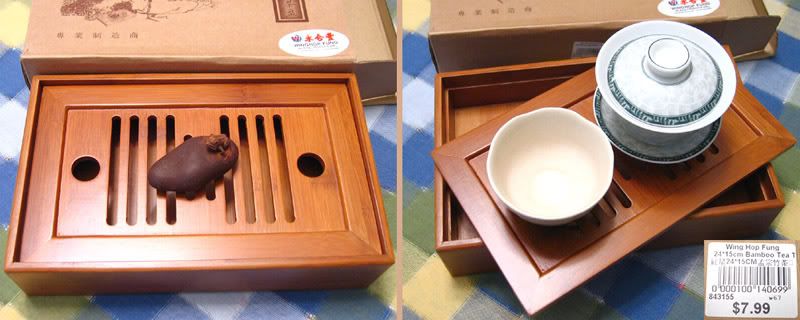 I like to browse at their teaware selections, which are decently priced, comparatively speaking. This time, I came across a small bamboo tea tray (24 x 15 x 6cm) that I thought would be perfect for traveling. It's small and light enough to be carried in a carry-on bag. It is also relatively well made. The best part is…it’s only eight bucks. I took one home. Not a bad find, me think.
I like to browse at their teaware selections, which are decently priced, comparatively speaking. This time, I came across a small bamboo tea tray (24 x 15 x 6cm) that I thought would be perfect for traveling. It's small and light enough to be carried in a carry-on bag. It is also relatively well made. The best part is…it’s only eight bucks. I took one home. Not a bad find, me think.